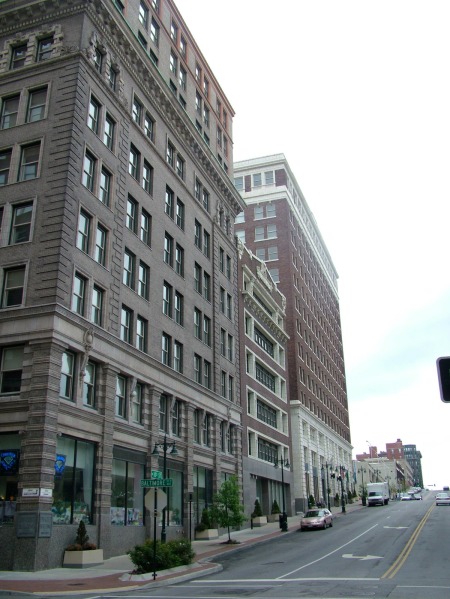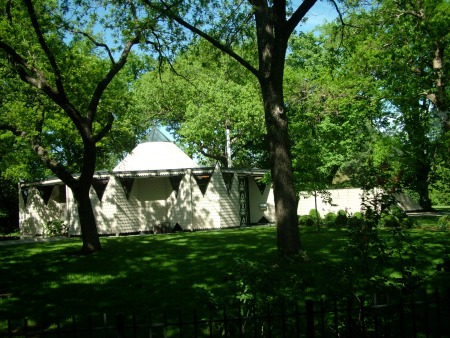We had our National Trust Board meeting in Kansas City last week, showcasing a city where preservation has made a palpable difference, notably in the downtown Library District. Chair Emeritus Jonathan Kemper led the effort to convert a former bank into a library – taking advantage of the fact that both banks and libraries in the early 20th century relied on the Classical Revival.

The interior was done VERY well, using the open plan of the lower banking floors and somehow making the upper stories work, tucking an added floor in without being visible to the street and finding an interior architecture that was an enthusiastic about Classical Revival as the original architects were.

A building well preserved always leads to more restored buildings in the area.

and the library theme is carried out in book-spine architecture ornamenting a downtown fountain and perhaps the most serendipitous parking structure around

Of course, there is the fantastic Union Station, an early 90s preservation effort that is quite spectacular and thankfully still a train station, unlike St. Louis’…

No visit to Kansas City is complete without paying your respects to the Guanyin at the Nelson-Atkins, a Liao dynasty polychrome wood masterpiece that assimilates the cultural swell of Northern Song landscape and calligraphy with a millenium of Buddhist imagery and balances it upon the tipping point of the Asian feminization of the Boddhisatva Avalokiteshvara.

We drove around Union Hill and through Country Club Plaza with its Seville Revival aesthetic and the ubiquitous Colonial Revival of the surrounding boulevarded residential districts but as always I was struck by the indescribably local and indubitably particular, which in Kansas City are the “collonades,” these extended porches with Classical columns and balusters you find throughout town and not in quantity anywhere else


and then there are the architects you seek out, like Bruce Goff

and of course, Barry Byrne. I have written the (unpublished) book on Barry Byrne and I have had the good fortune of lecturing at several of his structures in the last year, including the Church of Christ the King in Tulsa and Academie Ste Cecile (former Holy Redeemer Seminary) in Windsor. The parish of St. Francis Xavier invited me to speak for their 100th anniversary and it was a great opportunity for several reasons. NOTE: All of the following photographs are by Felicity Rich (www.felicityrich.com).

Reason one is of course that this church has a congregation and ownership that understand what a great building it is and have respected and cared for it so that it continues to serve the ecclesiastical purpose Byrne designed it for 60 years ago. Architect and parishioner Reeves Weidemann showed us what he did, which was marvelously minimal.

They cleaned the upper reaches of the dramatic limestone exterior, a great elliptical sweep of smooth mid-century modern solidity made more solid by the judicious and careful application of voids and suggested voids. Look at how artfully be balances the verticals and horizontals into a moving, breathing architecture.

This is the first fish-shaped church (sorry Harrison – you were five years late) but Byrne of course would never design for symbolism. He chose the elliptical form because it focused attention on the altar. And at the dedication, Rev. Daniel Lord, S.J. spoke of the fish symbolism – the first symbol of early Christianity, long before crucifixes were employed – but he also spoke of the exterior as a ship steaming into the future, and it really does look like that.

The wedge of the tower carves into the air and the side aisles and pointed prow of the porte cochere, extended to a massive limestone Iannelli sculture of Xavier make the church appear a sleek dreadnought. This is a dynamic architecture, not the last bit static or the least bit dated. Byrne loved Chartres because it was architecture, and as Reeves said in introducing me, timeless architecture is like that – it always looks good and works well because it is not about fashion.

There is even an echo of Byrne’s experience as the constructing architect of Oak Park’s Unity Temple for Frank Lloyd Wright in the attached rectory, whose cantilevered roof slabs and banded windows recall Byrne’s Prairie schooling.

We first visited St. Francis Xavier in July 2001 and we were pleased with how well it had survived. The sleek steel cage baptistery and raised mother’s room survived in the rear, and I first witnessed the visual logic of this amazing interior. The communion rail which the framers of Vatican II found divisive is a thin slab of black marble atop rectangular balusters that match the stone behind, so when you are seated it dissolves into a simple black line. Every element of the interior, from the windowless center of the nave to the ridge light force your attention forward to the altar. The piers supporting the elliptical clerestory are wedge-shaped like the tower, their lower portions painted gray so they disappear and the nave hovers in blue and white light, a paramount example of the spirituality of abstraction.

I heard they had made the church more accessible, and feared the worst, having witnessed so many clumsy architectural felonies in the name of ADA but no, Reeves created accessibility behind the chapel, not disturbing the original sanctuary, proof that with good architectural thinking, there is always a way to do it right. They also carefully saved the exquisite interior painting scheme, which was originally balanced by low amber windows, replaced in the 90s with blue because late afternoon sun was too harsh and Byrne designed prior to the advent of evening mass.

Byrne and Iannelli considered this perhaps their greatest work, and Iannelli was in the zone, from the forceful exterior Xavier emerging from the rough limestone to the towering aluminum Christ as Sovereign Priest that makes the incredible visual sweep of the interior worthwhile.

Architect Frank Grimaldi was in the audience and he had worked on the church with Iannelli and recalled the sculptor’s attention to this sculpture and all of the interior details (the side altars to Mary and Joseph are also fantastic.)

Iannelli’s incredible stations of the cross are perhaps even more amazing than his singular sculptures because he crafts whole narrative worlds with deceptively minimal gestural forms and simple incised lines – there are no wasted strokes here.

Like my visit to Tulsa and Windsor (and Racine and Chicago and St. Paul) I was impressed with how well the community is taking care of Byrne and Iannelli’s design. Perhaps all it takes is the recognition of what that design gives to the community. This is a fundamental preservation precept: landmarks give something – a enduring and inspiring place for spiritual, communal celebration, in this case – and the community responds by maintaining that place. A building like St. Francis Xavier I think gives the lie to the Goethian quote about architecture being frozen music. It isn’t frozen at all – it is dynamic and living. We preserve buildings not to freeze them but to perpetuate their vibrant and living dynamism. Some people get that.
tomorrow off to China…
Tags: Barry Byrne, Felicity Rich, St. Francis Xavier Kansas City
Leave a comment